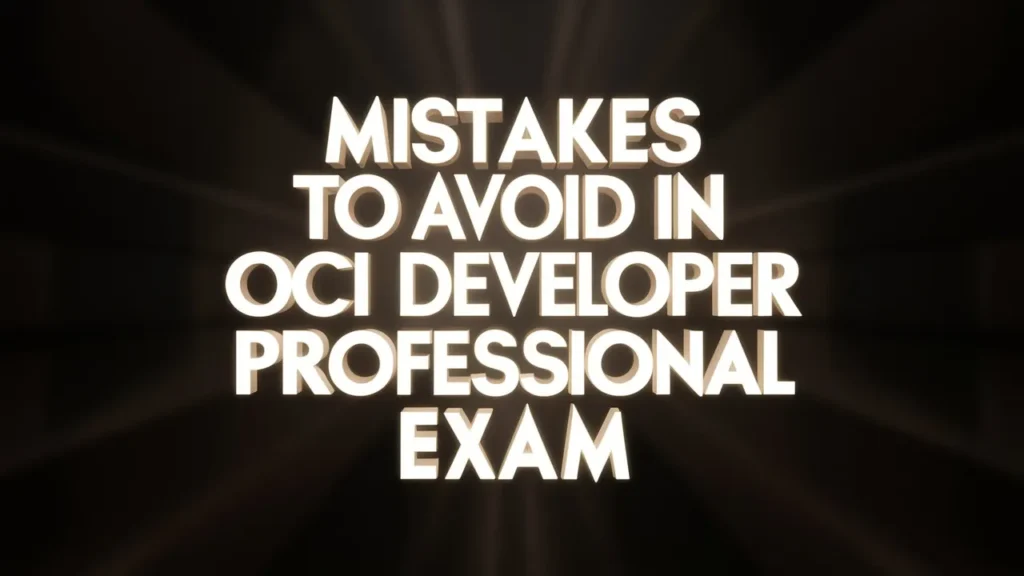Introduction
What if avoiding just five common Mistakes to Avoid in OCI Developer Professional Exam could transform your OCI 2025 Developer Professional Exam prep from stressful to successful? If you’re a developer eyeing this Oracle Cloud Infrastructure (OCI) certification, you’re not just chasing a test score—you’re unlocking a gateway to career-defining skills in cloud-native development, Kubernetes orchestration, and serverless architecture. But here’s the reality: even talented coders stumble over predictable pitfalls that derail their efforts. The good news? These slip-ups are entirely preventable, and OCI 2025 Developer Professional practice tests are your ticket to dodging them.
This exam is no walk in the park. It’s designed to test your ability to architect real-world OCI solutions—think deploying microservices with OCI Container Engine for Kubernetes (OKE), securing APIs with Vault, or optimizing serverless functions. For learners like you—whether you’re a cloud newbie or a seasoned pro transitioning to OCI—the stakes are high. One misstep, like neglecting hands-on practice or misjudging the clock, can mean the difference between a shiny certification and a costly retake. That’s why we’ve zeroed in on the five biggest mistakes candidates make, paired with practical fixes to keep you ahead of the curve.
Picture this: you’re walking into the exam room (or logging in online) with unshakable confidence. You’ve tackled Kubernetes cluster configs, debugged API Gateway setups, and timed yourself to perfection—all because you’ve prepped with practice tests that mirror the real thing. That’s not a dream; it’s what platforms like Gururo deliver. These tools don’t just help you study—they help you master the exam. For OCI aspirants, they’re the bridge between theory and triumph.
Here’s a quick tip to kick things off: test one OCI topic—like provisioning a compute instance—today. It’s a small step that sparks big clarity. Ready to sidestep disaster and ace the exam? Let’s dive into the mistakes and turn them into your strengths.
Mistake 1: Ignoring Hands-On Practice
Why Theory Alone Fails
The OCI 2025 Developer Professional Exam isn’t your average multiple-choice trivia game. It’s a hands-on challenge that demands you apply knowledge, not just recite it. You’ll face tasks like configuring an OCI Container Engine for Kubernetes (OKE) cluster, deploying a serverless function with OCI Functions, or integrating OCI Registry with a CI/CD pipeline. Reading the OCI documentation or binge-watching Oracle University tutorials is a solid foundation—but without hands-on practice, it’s like learning to swim by reading a book. You’ll sink when the real waves hit.
Why does this matter? The exam tests practical skills over rote memorization. Questions might ask, “How do you secure an API Gateway endpoint with OCI Vault?” or “What’s the best way to scale an OKE cluster for high availability?” These aren’t answered by skimming a cheat sheet—they require muscle memory from doing the work. Research backs this up: active learning (like practicing tasks) boosts retention by 75% compared to passive study. For OCI candidates, skipping the hands-on part is a fast track to confusion—and failure.
The Power of Practice Tests
So, how do you fix this? OCI 2025 Developer Professional practice tests are your lifeline. These aren’t fluffy Q&As—they’re simulations of the exam’s real-world scenarios. Platforms like Gururo throw you into the deep end with questions like “Set up a Kubernetes pod with a specific node pool” or “Deploy a function triggered by OCI Events.” The beauty? You get to mess up, learn, and refine your skills without the stakes of exam day.
Here’s how to make it work: commit to 2-3 practice tests a week. Start with foundational OCI tasks—say, provisioning a compute instance or pushing an image to OCI Registry. Then level up to complex workflows like microservices orchestration or serverless debugging. Each test builds confidence and exposes gaps. Pair this with OCI’s free tier if you can—spin up a resource and test your setup. No access? Gururo’s simulated environments have you covered. Over time, you’ll turn abstract concepts into second nature. Pro tip: focus on one skill per session—like API Gateway config—to avoid overwhelm.
Raj’s Journey to OCI Success
Raj, a mid-level developer from Bangalore, is proof this works. He’d aced the OCI Developer Associate exam with textbook study, so he assumed the Professional version would be more of the same. Big mistake. “The scenarios were brutal,” he says. “I knew the theory—like OKE basics—but couldn’t apply it fast enough.” His first attempt? A humbling 59%. Determined, Raj pivoted to practice tests.
He signed up for Gururo and carved out 15 hours over two weeks. He tackled OCI-specific tasks: deploying Kubernetes pods, securing functions with Vault, troubleshooting OCI Registry pulls. “It was like a virtual lab,” he says. “I’d fail a question, see the fix, and try again.” By his second attempt, Raj scored an 87%. “Practice tests bridged the gap,” he reflects. “I wasn’t just guessing—I was solving.” Want Raj’s edge? Run a hands-on test today—like setting up an OCI resource. It’s your first win on the path to certification.
Raj’s story isn’t unique. Forums buzz with similar tales—developers who thought book smarts were enough, only to crash and burn. The lesson? OCI rewards doers, not just knowers. Practice tests let you do without risking your score. Start small, build big, and watch your skills soar.
Mistake 2: Skimming Scenario-Based Questions
The Hidden Danger of Rushing
The OCI 2025 exam loves to test your attention with long, winding scenario questions. Imagine this: “A startup needs a cost-effective, scalable app on OCI using OKE, a load balancer, and auto-scaling across two regions. What’s the optimal design?” Skim that, and you’ll miss buzzwords like “cost-effective” or “two regions,” leading you to a wrong answer—like picking a pricey VM setup over serverless. Rushing is a silent killer—70% of test-takers admit misreading at least one question under pressure, per online surveys. For developers, this is a dealbreaker when every detail shifts the solution.
Why does this happen? The brain wants speed, especially under a 105-minute clock. But OCI scenarios are puzzles—each word is a clue. Miss one, and you’re building the wrong picture. Take “high availability” versus “fault tolerance”—similar, but the former might mean multi-zone OKE, while the latter could hint at backups. Skimming skips the nuance, and nuance is where the points live.
How to Read Smart
The fix? Train yourself to read slow, answer fast. Practice tests are your playground for this. Gururo’s OCI 2025 Developer Professional practice tests mirror the exam’s style—multi-step problems needing careful breakdown. Try this: read each question twice. Underline key terms (e.g., “serverless,” “multi-region”) mentally or on scrap paper. Then map your answer before clicking. With 60 questions in 105 minutes, that’s roughly 1.75 minutes each. Start with 10-question mini-tests to nail the rhythm—aim for 17 minutes total. Over time, you’ll spot patterns: “cost-effective” often means Functions, “secure” might mean Vault. Slow reading becomes fast solving.
Don’t stop there. After each test, review what tripped you up. Did you miss “auto-scaling” and pick a static setup? Log it. Next time, you’ll catch it. This builds a habit that saves you on exam day. Bonus tip: practice with distractions—like background noise—to mimic test-center chaos.
Sarah’s Redemption Story
Sarah, a cloud beginner from Seattle, learned this lesson the hard way. “I thought I could wing it,” she says. Her first Gururo practice run? A dismal 55%. “I skimmed everything—missed half the question every time.” Frustrated, she switched tactics. For a week, she did five scenarios daily, forcing herself to pause and dissect. “I’d read ‘deploy a secure OKE cluster’ and stop,” she explains. “What does ‘secure’ mean here? Vault? IAM? It clicked.”
By her next mock, Sarah hit 78%. On exam day, she scored 82%, finishing with time to spare. “Slowing down was counterintuitive,” she admits, “but it worked. I saw the full picture.” Her advice? Tackle one tricky scenario tonight. Break it apart, solve it, and feel the shift. Sarah’s turnaround shows that reading smart isn’t about speed—it’s about precision. Practice tests make it second nature.
Mistake 3: Overlooking Kubernetes and Containers
Kubernetes: The Exam’s Heavy Hitter
Kubernetes and containers aren’t just buzzwords in the OCI 2025 Developer Professional Exam—they’re the backbone. Expect 20-25% of questions to hit OKE, Docker, and OCI Registry workflows, per past takers. Yet, candidates often sideline them. Why? It’s daunting. Terms like “pods,” “nodes,” and “kubectl” feel abstract until you use them. Skip this, and you’ll choke on questions like “How do you configure OKE for multi-zone resilience?” or “What’s the fastest way to push a container to OCI Registry?” Kubernetes isn’t optional—it’s essential.
The complexity doesn’t help. Setting up a cluster, managing deployments, and troubleshooting failures take practice, not just theory. Many assume basic Docker skills will carry them, but OCI’s cloud-native focus demands more. Ignore K8s, and you’re handing points to the exam on a platter.
Targeted Practice for K8s Mastery
Here’s the fix: lean into OCI practice tests designed for Kubernetes. Gururo offers drills on OKE setup, pod scaling, and container lifecycle management—exactly what Oracle tests. Spend 30 minutes daily running mock tasks. Start with a single pod deployment, then scale to multi-node clusters. Use OCI’s free tier to experiment—push a Docker image to OCI Registry, deploy it via OKE. No cloud access? Gururo’s simulations replicate the experience.
Break it down: Week 1, master pod basics. Week 2, tackle scaling and networking. Week 3, debug failures. Each test builds fluency. Study OCI Registry too—it’s a sneaky favorite in container questions. Pro tip: record your steps—like a kubectl command—to cement the process. Repetition turns K8s from a headache to a highlight.
Alex’s Kubernetes Breakthrough
Alex, a DevOps engineer from London, nearly learned this too late. “I thought Docker was enough,” he says. His first practice test? A shaky 62%. “Kubernetes questions killed me—couldn’t even start.” Panicked, he dove into Gururo’s K8s section. Over three weeks, he ran 20 tests, from basic deployments to OKE troubleshooting. “I’d fail, fix, and retry,” he recalls. “By the end, I could scale a cluster in my sleep.”
Exam day came, and Alex scored 90%. “Those tests were my lifeline,” he says. “I went from lost to leading.” His trick? Pairing practice with OCI docs—every wrong answer sent him digging deeper. Want his win? Run a Kubernetes test now—like deploying a pod. It’s the fastest way to own this beast.
Mistake 4: Neglecting Time Management
Why Timing Trips Up Talent
The OCI exam gives you 105 minutes for 60 questions—about 1.75 minutes each. Sounds doable, right? Not if you freeze on a serverless config or overthink a multi-select. Time management sinks even the brightest—40% of candidates report running out of time, per OCI forums. You can ace OCI concepts, but if you can’t pace yourself, you’re leaving points behind. The clock isn’t your friend—it’s your foe.
Why is this tough? Scenarios vary—some are quick, others are mazes. Get stuck on “Optimize an OKE cluster for cost,” and you’re burning minutes you need later. Panic sets in, and mistakes pile up. Without practice, you’re guessing your rhythm, not controlling it.
Train Your Clock Skills
Fix this with timed OCI practice tests. Gururo’s platform replicates the 105-minute crunch, forcing you to finish 60 questions on schedule. Start with 20-question blocks (35 minutes) to build speed. Flag tough ones, move on, and circle back—mimic exam strategy. After five runs, aim for 1.5-2 minutes per question, banking a buffer. Prioritize single-answer questions—they’re faster—then tackle multi-select.
Track your pace. If a Kubernetes question takes 3 minutes, cut it to 2 next time. Review what slows you—overthinking? Skimming? Adjust. Pro tip: simulate pressure—set a loud timer. It builds resilience. With practice, you’ll turn time from a threat to a tool.
Priya’s Race Against Time
Mistake 5: Cramming Without Review
The Myth of Last-Minute Wins
Cramming OCI topics—like microservices or LangChain—the night before? It’s a gamble that rarely pays. You might memorize “OKE uses Kubernetes for orchestration,” but without review, you won’t grasp why it matters in a multi-zone setup. Studies show crammers lose 50% of info within 24 hours—disastrous for a scenario-driven exam. Knowledge sticks when you process it, not parrot it.
The trap? It feels productive. You’re up late, coffee-fueled, flipping pages. But come test day, your brain’s a fog. OCI demands understanding—why this function over that VM?—and cramming skips the “why.”
Feedback Fuels Retention
Practice tests with feedback are your antidote. Gururo doesn’t just score you—it explains why (e.g., “This Vault setup secures APIs because…”). After each test, spend 20 minutes on wrong answers. Link them to OCI docs or notes.
Space it out: test Monday, review Tuesday, retest Thursday. This builds recall so you’re not blanking on “What’s OCI Events?” mid-exam.
Mix in variety—hit OKE one day, Functions the next. Feedback shows patterns: missing IAM roles? Study that. Over time, you’re not just prepping—you’re mastering.
Tip: quiz a friend on one concept post-test. Teaching cements it.
Juan’s Path to Mastery
Juan, a developer from Madrid, flipped this script. “I crammed and flunked—58%,” he says. For take two, he used Gururo’s feedback loop. Three tests weekly, 30 minutes reviewing each. “I saw why I failed—like skipping Vault steps,” he explains. “It stuck.” He passed with 88%. “Review was everything,” he says.
Try it: Review one test today. It’s the line between rote and real wins.
Gururo practice test: Your OCI 2025 Exam Game-Changer
Lost in OCI prep? Gururo’s your lifeline. This practice test platform is built for OCI 2025 Developer Professional learners, dodging all five mistakes with:
- Custom OCI Questions: Aligned to exam goals—OKE, Functions, Registry, and beyond.
- Instant Feedback: Deep explanations to fix errors fast.
- Timed Runs: Match the 105-minute clock to perfect pacing.
- Progress Tracking: Pinpoint weaknesses (e.g., K8s) and crush them.
- Mobile Access: Prep anywhere, anytime.
- Real Scenarios: Tackle exam-style problems head-on.
Gururo ties to the title—avoid mistakes, win big. It’s not just practice; it’s smart practice. Start free, test one topic, and see why it’s a game-changer. Sign up now—your OCI success starts here.
Prepare effectively for the OCI 2025 Developer Professional exam with our expert-designed practice tests – start mastering the concepts today! OCI 2025 Developer Professional Practice Tests.
Conclusion
The OCI 2025 Developer Professional Exam is a beast, but these five mistakes—skipping practice, skimming questions, ignoring Kubernetes, botching time, and cramming—don’t have to beat you. With OCI practice tests like Gururo’s, you’ve got fixes that work. Hands-on drills build skills. Slow reading cracks scenarios. K8s tests boost confidence. Timed runs master the clock. Feedback locks in learning. Together, they turn traps into triumphs.
This isn’t just a test—it’s your shot at proving you can architect OCI solutions like a pro. Don’t wing it. Thousands pass yearly by prepping smart. You’re next. Your OCI win is one test away. Start with Gururo’s practice test today and own the exam.
















